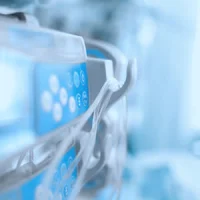Most forms of ventilatory support in intensive care before the 1950s were noninvasive without direct access to the lower airways, using face mask for positive pressure or generating negative pressure around the chest. Ventilators stimulating negative pressure were designed in the late 19th century. The first application of positive end-expiratory pressure (PEEP) was first described in the 1930s.
After the introduction of positive-pressure ventilation, it still took some time to fully discover noninvasive positive-pressure ventilation. Home ventilation started at the end of the 1980s in patients with chronic respiratory disorders. The goal was to improve quality of life compared to tracheostomy. The use of home ventilatory support was also driven by the realisation that sleep disturbances could be caused by abnormal respiration.
Along with the development of home ventilators, noninvasive ventilation (NIV) techniques began to be applied during the early 1990s to avoid endotracheal intubation. A greater understanding of the pathophysiology of ventilatory failure and respiratory muscle activity and the development of pressure support ventilation on ICU ventilators facilitated the introduction of noninvasive ventilation, and its use expanded to more heterogeneous clinical scenarios.
One of the biggest incentives to develop NIV was the recognition of the complications of invasive mechanical ventilation. Even during the pandemic, this issue was in focus as a shortage of equipment and personnel accelerated the use of techniques such as high-flow nasal cannula (HFNC), NIV and continuous positive airway pressure (CPAP) to prevent intubation. Noninvasive support is also useful in palliative care to relieve dyspnoea in patients who are not eligible for invasive ventilation.
Facemask NIV helps improve gas exchange, reduces work of breathing and improves clinical outcomes in patients with hypercapnic respiratory failure due to COPD, obesity-hypoventilation, and cardiogenic pulmonary oedema. NIV has also shown positive results when used in postoperative hypoxaemia, and can facilitate weaning from mechanical ventilation in ICU patients at a high risk of reintubation. Several trials have demonstrated the successful use of NIV during de novo hypoxemic respiratory failure.
However, some observational studies also show that patients intubated after a failing trial of noninvasive support are burdened by higher mortality, possibly due to delayed intubation and self-inflicted lung injury. Previous studies have not shown the benefits of CPAP for hypoxaemic respiratory failure, and more clinical evidence is still needed. However, CPAP has been shown to be beneficial in post-operative respiratory failure.
Overall, NIV is recommended in hypercapnic respiratory failure due to COPD exacerbation and cardiogenic pulmonary oedema and has been conditionally recommended as a prophylaxis for extubation failure in high-risk patients and to facilitate weaning in hypercapnic patients. However, the successful application of NIV is dependent on several factors, including good patient selection, patient-ventilator interface, personnel expertise, and patient monitoring.
No recommendations have been made in recent guidelines for the use of facemask NIV in de novo hypoxemic respiratory failure, and there is still a need to find new strategies for noninvasive support in this population. The helmet represents an attractive interface for CPAP or NIV in hypoxaemic patients and is generally well tolerated for prolonged treatments. But the use of this interface is still limited by the lack of conclusive data to enable clinical recommendations.
Low-flow oxygen therapy via nasal cannula or oxygen mask is also routinely used during initial patient management. However, the maximum flow rate of 15 L/min is inadequate to control FiO2 or to reduce work of breathing in patients with acute respiratory failure in whom peak inspiratory flows often largely exceed 30 L/min. Insufficient heating and humidification with a low-flow oxygen device can lead to discomfort and poor tolerance. Current HFNC systems can deliver high flow rates of heated and humidified air-oxygen mixture up to 60 L/min via a large-bore nasal cannula and are well tolerated.
HFNC offers several benefits in patients with acute respiratory failure by improving gas exchange and modulating inspiratory effort via flow-dependent small positive-pressure effect, upper airway wash-out, and active heating and humidification. Findings have demonstrated that HFNC reduced the rate of endotracheal intubation in patients with moderate-to-severe hypoxaemia compared to conventional oxygen therapy and facemask NIV and improved survival.
Current guidelines recommend HFNC as the first-line treatment of de novo hypoxemic respiratory failure. HFNC has also been shown to prevent post-extubation respiratory failure in critically ill patients weaned from invasive mechanical ventilation compared to conventional oxygen therapy and has performed as well as prophylactic NIV in patients at high risk of post-extubation respiratory failure. NIV may also be a good choice in obese patients, alone or in combination with HFNC.
Therefore, NIV should be considered the first-line approach to treat patients with hypercapnic respiratory failure and CPAP or NIV for respiratory failure due to acute cardiogenic pulmonary oedema. Weaning or extubation can also be facilitated by HFNC and NIV. However, noninvasive support for de novo hypoxemic respiratory failure is still unclear. HFNC and helmet support are promising techniques, but outcomes depend on careful patient selection and clinical monitoring to balance the benefits and risks of these approaches.
Source: Intensive Care Medicine
Image Credit: iStock
References:
Rittayamai N, Grieco DL, Brochard L (2022) Noninvasive respiratory support in intensive care medicine. Intensive Care Med. doi.org/10.1007/s00134-022-06762-6
Latest Articles
CPAP, HFNC, NIV, noninvasive respiratory support
Noninvasive Respiratory Support in Intensive Care







